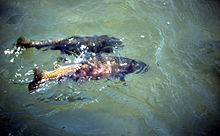
Back لاسلويات Arabic Анамниялар BA Анамніі BE Анамніі BE-X-OLD অন্তঃভ্রূণাবরণীহীন প্রাণী Bengali/Bangla Anamnioti BS Anamniota Catalan Bezblanní Czech Anamnia German Anamniota Spanish
| Anamniotes | |
|---|---|

| |
| Trout spawning showing typical anamniote external fertilization | |

| |
| Anamniotes have a distinct larval stage, such as in the smooth newt. | |
| Scientific classification | |
| Domain: | Eukaryota |
| Kingdom: | Animalia |
| Phylum: | Chordata |
| Subphylum: | Vertebrata |
| (unranked): | Ichthyopsida Huxley, 1863 |
| Groups included | |
| Cladistically included but traditionally excluded taxa | |
The anamniotes are an informal group of craniates comprising all fish and amphibians, which lay their eggs in aquatic environments. They are distinguished from the amniotes (reptiles, birds and mammals), which can reproduce on dry land either by laying shelled eggs or by carrying fertilized eggs within the female. Older sources, particularly before the 20th century, may refer to anamniotes as "lower vertebrates" and amniotes as "higher vertebrates", based on the antiquated idea of the evolutionary great chain of being.
The name "anamniote" is a back-formation word created by adding the prefix an- to the word amniote, which in turn refers to the amnion, an extraembryonic membrane present during the amniotes' embryonic development which serves as a biochemical barrier that shields the embryo from environmental fluctuations by regulating the oxygen, carbon dioxide and metabolic waste exchanges and secreting a cushioning fluid. As the name suggests, anamniote embryos lack an amnion during embryonic development, and therefore rely on the presence of external water to provide oxygen and help dilute and excrete waste products (particularly ammonia) via diffusion in order for the embryo to complete development without being intoxicated by their own metabolites.[1] This means anamniotes are almost always dependent on an aqueous (or at least very moist) environment for reproduction[2] and are thus restricted to spawning in or near water bodies. They are also highly sensitive to chemical and temperature variation in the surrounding water, and are also more vulnerable to egg predation and parasitism.
During their life cycle, all anamniote classes pass through a completely aquatic egg stage, as well as an aquatic larval stage during which all hatchlings are gill-dependent and morphologically resemble tiny finless fish (known as a fry or a tadpole for fish and amphibians, respectively), before metamorphosizing into juvenile and adult forms (which might be aquatic, semiaquatic or even terrestrial), thus indicating their physiological homology.
- ^ Carroll, R. L. (1991). "The origin of reptiles". In Schultze, H.-P.; Trueb, L. (eds.). Origins of the higher groups of tetrapods — controversy and consensus. Ithaca: Cornell University Press. pp. 331–353. ISBN 978-0-8014-2497-7.
- ^ Colbert, E. H.; Morales, M. (2001). Colbert's Evolution of the Vertebrates: A History of the Backboned Animals Through Time (4th ed.). New York: John Wiley & Sons. ISBN 978-0-471-38461-8.